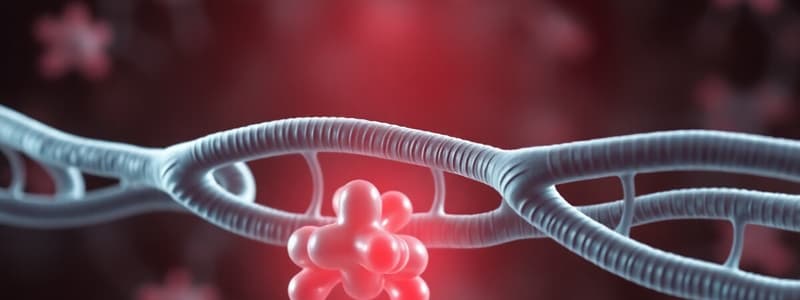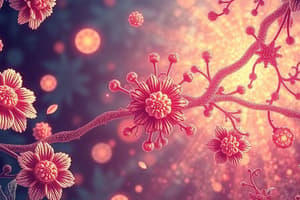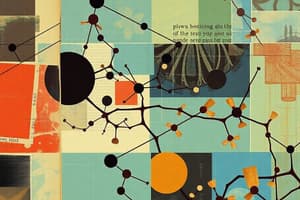Podcast
Questions and Answers
What is required for a drug and receptor to interact in the cell?
What is required for a drug and receptor to interact in the cell?
- They must be located in the nucleus
- They must both be proteins
- They must be complementary to each other (correct)
- They must be present in equal concentrations
Where must the drug and receptor be located to ensure proper interaction?
Where must the drug and receptor be located to ensure proper interaction?
- In the endoplasmic reticulum
- In the cytoplasm or nucleus (correct)
- In the cell membrane only
- In the mitochondria
Which statement best describes the interaction of a ligand with its receptor?
Which statement best describes the interaction of a ligand with its receptor?
- The receptor must be located on the cell surface
- Only the ligand needs to be small in size
- They need to have complementary shapes (correct)
- They must be identical in structure to bind effectively
Which of the following factors is NOT important for the binding of a ligand to its receptor?
Which of the following factors is NOT important for the binding of a ligand to its receptor?
What role does complementarity play in the interaction between a drug and its receptor?
What role does complementarity play in the interaction between a drug and its receptor?
What is indicated by the threshold dose in a dose-response relationship?
What is indicated by the threshold dose in a dose-response relationship?
Which axis represents the dose in a typical dose-response curve?
Which axis represents the dose in a typical dose-response curve?
Which statement about the threshold dose is true?
Which statement about the threshold dose is true?
At a specific threshold dose, which of the following occurs?
At a specific threshold dose, which of the following occurs?
Why is the threshold dose important in pharmacology?
Why is the threshold dose important in pharmacology?
What does pharmacodynamics primarily focus on?
What does pharmacodynamics primarily focus on?
Which of the following best describes drug specificity?
Which of the following best describes drug specificity?
Which type of antagonist irreversibly binds to the receptor?
Which type of antagonist irreversibly binds to the receptor?
What is the primary feature of an agonist?
What is the primary feature of an agonist?
What does a dose-response curve illustrate?
What does a dose-response curve illustrate?
What is the primary consideration when evaluating drug effectiveness regarding dosage?
What is the primary consideration when evaluating drug effectiveness regarding dosage?
Why is it important to identify a drug that reaches a fixed point with a smaller dose?
Why is it important to identify a drug that reaches a fixed point with a smaller dose?
Which factor is NOT considered when determining a drug's effectiveness at reaching a fixed point?
Which factor is NOT considered when determining a drug's effectiveness at reaching a fixed point?
What does high affinity in drug-receptor interactions indicate?
What does high affinity in drug-receptor interactions indicate?
When assessing drug potency, what does a smaller dose indicate?
When assessing drug potency, what does a smaller dose indicate?
Which of the following statements accurately reflects drug dosage considerations?
Which of the following statements accurately reflects drug dosage considerations?
What is the formula used to define affinity?
What is the formula used to define affinity?
Which of the following best describes efficacy in drug-receptor interactions?
Which of the following best describes efficacy in drug-receptor interactions?
In the context of drug interactions, what does a low Kd value signify?
In the context of drug interactions, what does a low Kd value signify?
If a drug has low efficacy, what could be inferred about its ability to produce a cellular response?
If a drug has low efficacy, what could be inferred about its ability to produce a cellular response?
What does a wider therapeutic index indicate?
What does a wider therapeutic index indicate?
What does LD50 represent?
What does LD50 represent?
What are the two key analyses required before a drug can be marketed?
What are the two key analyses required before a drug can be marketed?
When is a drug considered not safe based on its therapeutic index?
When is a drug considered not safe based on its therapeutic index?
What happens to the therapeutic index as the curves for effective and lethal doses become narrower?
What happens to the therapeutic index as the curves for effective and lethal doses become narrower?
Flashcards
Ligand
Ligand
A molecule that binds to a receptor, initiating a cellular response.
Receptor
Receptor
A protein on the cell surface that binds to a specific ligand, triggering a cellular response.
Complementary
Complementary
The shapes of a ligand and its receptor must fit perfectly for binding to occur.
Cytoplasm
Cytoplasm
Signup and view all the flashcards
Nucleus
Nucleus
Signup and view all the flashcards
Affinity
Affinity
Signup and view all the flashcards
Kd
Kd
Signup and view all the flashcards
Drug-Receptor Interaction
Drug-Receptor Interaction
Signup and view all the flashcards
Efficacy
Efficacy
Signup and view all the flashcards
Intrinsic Activity
Intrinsic Activity
Signup and view all the flashcards
Threshold Dose
Threshold Dose
Signup and view all the flashcards
Dose-Response Relationship
Dose-Response Relationship
Signup and view all the flashcards
X-axis
X-axis
Signup and view all the flashcards
Effect
Effect
Signup and view all the flashcards
Dose
Dose
Signup and view all the flashcards
Pharmacodynamics
Pharmacodynamics
Signup and view all the flashcards
Drug Target
Drug Target
Signup and view all the flashcards
Drug Specificity
Drug Specificity
Signup and view all the flashcards
Dose-Response Curve
Dose-Response Curve
Signup and view all the flashcards
Drug Potency
Drug Potency
Signup and view all the flashcards
Fixed Point
Fixed Point
Signup and view all the flashcards
Smaller Dose
Smaller Dose
Signup and view all the flashcards
Compare Drug Potency
Compare Drug Potency
Signup and view all the flashcards
Drug Effectiveness
Drug Effectiveness
Signup and view all the flashcards
Therapeutic Index
Therapeutic Index
Signup and view all the flashcards
Safer Drug
Safer Drug
Signup and view all the flashcards
Toxic Drug
Toxic Drug
Signup and view all the flashcards
Study Notes
Pharmacodynamics 1 Lecture Notes
- Pharmacodynamics is the study of what a drug does to the body. It describes the effects of a drug on the human body.
- Pharmacokinetics describes how the human body behaves with the drug. (e.g., absorption, metabolism)
- Drugs do not create new functions; they modify existing ones. The drug will target specific sites in the cell to work.
- For a drug to be helpful as a tool, it must act selectively on specific cells or tissues.
- Drugs are targeted at specific sites in the cells; for it to work, it must be able to target a specific site in the cell.
- Drug targets are proteins: these include enzymes, carrier proteins, ion channels, and receptors.
- Enzymes are proteins; drugs can be competitive or irreversible noncompetitive inhibitors.
- Receptors are present on the cell surface, in the cytoplasm, or in the nucleus; drugs can be agonists (full or partial) or antagonists.
- Affinity is the ability of a drug to bind to the receptor. A higher Ka (association constant) means higher affinity.
- Efficacy is the ability of the drug complex to produce a cellular response (stimulation or initiation).
- A dose-response curve shows the relationship between drug dose and the resulting response.
- The response increases as the dose increases until the maximal response is reached.
- There is a threshold dose below which there is no response.
- All drugs are poisons if given in high doses; adverse events will occur.
- Therapeutic index is the ratio of the lethal dose (LD50) to the effective dose (ED50) and is used to evaluate/compare safety of drugs
- A higher therapeutic index indicates a safer drug.
- Agonists bind to a receptor, directly or indirectly, causing an effect, they have both affinity and efficacy. Full agonists have maximal effects while partial agonists do not.
- Antagonists bind to a receptor, but do not cause an effect, they only block agonists.
Types of Drug-Receptor Interactions
- Agonist - a drug that binds to a receptor and activates it, with a direct or indirect effect. Agonists have affinity and efficacy.
- Full Agonist - maximally stimulates the receptor.
- Partial Agonist - stimulates the receptor but can't reach maximal efficacy.
- Antagonist - binds to a receptor but does not cause an effect; it blocks the action of an agonist. Antagonists have affinity but no efficacy.
Competitive Antagonism
- Shifts the dose-response curve of the agonist to the right, but does not decrease its maximal response.
- Antagonist and agonist compete for the same binding site on the receptor.
- Increasing the concentration of the agonist can displace the antagonist.
Irreversible Antagonism
- Shifts the dose-response curve of the agonist downwards and to the right, decreasing its maximal response.
- Antagonist binds to a different site on the receptor, altering its conformation.
- Binding is irreversible, preventing the agonist from binding.
Quiz questions
- If a drug has an association constant (Ka) of 140 and a dissociation constant (Kd) of 2, what is its affinity? (Answer: 70)
- How many alpha subunits are present in a ligand-gated ion channel? (Answer: 5)
Studying That Suits You
Use AI to generate personalized quizzes and flashcards to suit your learning preferences.



